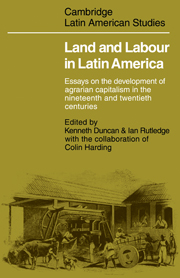 Land and Labourin Latin America
Land and Labourin Latin America Book contents
- Frontmatter
- Contents
- List of tables
- List of figures
- List of maps
- Acknowledgements
- 1 Introduction: patterns of agrarian capitalism in Latin America
- PART I THE TRANSITION FROM TRADITIONAL HACIENDA TO CAPITALIST ESTATE
- PART II THE DEVELOPMENT OF A PLANTATION ECONOMY WITH LABOUR RECRUITMENT FROM HIGHLAND PEASANT COMMUNITIES
- PART III THE DEVELOPMENT OF COMMERCIAL AGRICULTURE USING EUROPEAN IMMIGRANT LABOUR
- 12 The coffee colono of São Paulo, Brazil: migration and mobility, 1880–1930
- 13 The cereal boom and changes in the social and political structure of Santa Fe, Argentina, 1870–95
- PART IV THE TRANSITION FROM SLAVE PLANTATION TO CAPITALIST PLANTATION
- PART V POSTSCRIPT
- Glossary of Spanish and Portuguese terms used in the text
- Weights and measures
- Notes on contributors
- Indexes Subjects
- Authors
13 - The cereal boom and changes in the social and political structure of Santa Fe, Argentina, 1870–95
Published online by Cambridge University Press: 07 May 2010
- Frontmatter
- Contents
- List of tables
- List of figures
- List of maps
- Acknowledgements
- 1 Introduction: patterns of agrarian capitalism in Latin America
- PART I THE TRANSITION FROM TRADITIONAL HACIENDA TO CAPITALIST ESTATE
- PART II THE DEVELOPMENT OF A PLANTATION ECONOMY WITH LABOUR RECRUITMENT FROM HIGHLAND PEASANT COMMUNITIES
- PART III THE DEVELOPMENT OF COMMERCIAL AGRICULTURE USING EUROPEAN IMMIGRANT LABOUR
- 12 The coffee colono of São Paulo, Brazil: migration and mobility, 1880–1930
- 13 The cereal boom and changes in the social and political structure of Santa Fe, Argentina, 1870–95
- PART IV THE TRANSITION FROM SLAVE PLANTATION TO CAPITALIST PLANTATION
- PART V POSTSCRIPT
- Glossary of Spanish and Portuguese terms used in the text
- Weights and measures
- Notes on contributors
- Indexes Subjects
- Authors
Summary
The humid pampa of Argentina displays a series of social and economic characteristics that clearly mark it off from other rural areas of Latin America. Relatively speaking, the pampa farm or ranch (empresa rural) has a very high technical level by the standards of the rest of the continent. Its system of social stratification is notably more flexible and diverse than is to be found in the other Latin American republics. At the same time, the existence of a very favourable relationship between the amount of cultivable land and the size of the population means that the Argentine pampas have some features in common with the temperate grasslands of the western United States, Canada, Australia, and New Zealand.
These particular features of the pampa region are certainly not of recent origin - on the contrary, many of them have been present at least since the time Argentina became independent. The causes of this situation were naturally very various. Here I shall confine myself to dealing with three of the most important factors. Firstly, millions of hectares of highly fertile natural pasture land were available in the mid nineteenth century for agricultural development. Secondly, these territories were thinly populated both before and after the Conquest. Moreover, at the beginning of the nineteenth century most of the pampa was practically unexploited, being occupied only by roaming herds of wild cattle and a few tribes of nomadic Indians. The agricultural colonization of this immense frontier of fertile land kept land prices comparatively low throughout most of the nineteenth century, and this enabled various social groups, most of them immigrants, who had grown rich in urban or rural commerce, to acquire a stake in it.
- Type
- Chapter
- Information
- Land and Labourin Latin AmericaEssays on the Development of Agrarian Capitalism in the nineteenth and twentieth centuries, pp. 323 - 342Publisher: Cambridge University PressPrint publication year: 1978
- 3
- Cited by


